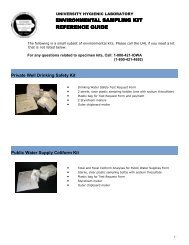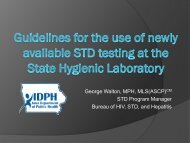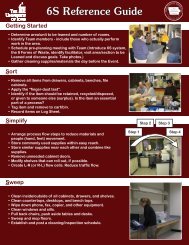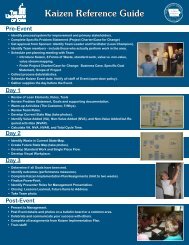Ammonia and Total Kjeldahl Nitrogen
Ammonia and Total Kjeldahl Nitrogen
Ammonia and Total Kjeldahl Nitrogen
You also want an ePaper? Increase the reach of your titles
YUMPU automatically turns print PDFs into web optimized ePapers that Google loves.
<strong>Ammonia</strong> <strong>and</strong> <strong>Total</strong> <strong>Kjeldahl</strong><strong>Nitrogen</strong>D O N S I M M O N S
Overview• Review methods (Part 1)• Why do we distill?• Review methods (Part 2)• Last thoughts
<strong>Ammonia</strong> Methods• Titration• Ion Selective Electrode• Colorimetric◦ Manual Phenate◦ Automated Phenate(Segmented-Flow Injection Analysis)◦ Flow Injection Analysis• Other Berthelot Reaction Methods (e.g., Timberlineetc)
Titration• Distillation required• <strong>Ammonia</strong>-free reagent water• Boric Acid Indicator solution• St<strong>and</strong>ardize 0.02 N Sulfuric Acid titrant• Interferences – Residual chlorine• Blank subtraction
<strong>Ammonia</strong>-Selective ElectrodePros• No colorimetric interferences• Easy to use – quickCons• Not good for dirty samples• Not as sensitive as colorimetric methods
<strong>Ammonia</strong>-Selective Electrode• >pH 11 <strong>and</strong> gas-permeable membrane• “Sample distillation is unnecessary.” SM 22 nd Ed.• Table 1B: Footnote 6. Distillation may be required ifany questions arise
Distillation• Manual distillation is not required if comparability data on representativeeffluent samples are on file to show that this preliminary distillation step isnot necessary: however, manual distillation will be required to resolve anycontroversies. In general, the analytical method should be consultedregarding the need for distillation. If the method is not clear, the laboratorymay compare a minimum of 9 different sample matrices toevaluate the need for distillation. For each matrix, a matrix spike <strong>and</strong>matrix spike duplicate are analyzed both with <strong>and</strong> without the distillationstep. (A total of 36 samples, assuming 9 matrices). If results arecomparable, the laboratory may dispense with the distillation step forfutureanalysis. Comparable is defined as < 20% RPD for all tested matrices).Alternatively the two populations of spike recovery percentages may becompared using a recognized statistical test.2012 MUR, Table IB, footnote 6.
Why we distill• Separation of ammonia from interferences• Highly turbid or colored water may interfere withcolorimetric analysis• High dissolved solids may affect determination usingion-selective electrode
Phenate Methods• Phenols react with hypochlorite <strong>and</strong> ammonia toform indophenol blue compounds that stronglyabsorb in the visible wavelength range (~630-660nm)• Nitroprusside catalyzes the reaction to formindophenol blue enhancing the absorbance
Interferences• Many interferences: Calcium, Magnesium, H2S,Turbidity – needs preliminary distillation.• Alkaline citrate solution will complex cations <strong>and</strong>keep them from ppt as hydroxides• Preliminary distillation will help reduce turbidity• Sulfide can be eliminated by acidification <strong>and</strong>vigorous aeration to remove as H2S.
Automated Phenate• Continuous Flow Injection vs Segmented FlowInjection• Flow Injection is simpler to use• Segmented flow – low dispersion, longer mixingtimes, RSD’s <strong>and</strong> Sensitivity better.• Discrete Analyzers
ATP procedures• TNT+ methods (epa 350.1)◦ Need comparison to reference method◦ Need distilled vs non-distilled comparison• Timberline methods◦ Do not need to distill….but◦ Good Laboratory Practice recommends you do the distilled vsnon-distilled comparison◦ Footnote 6 – still need to have capability of distilling ifquestions arise
Questions?• Contact information:• Don Simmons – 515-725-1600• donald-simmons@uiowa.edu• Thank you!










